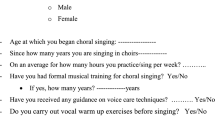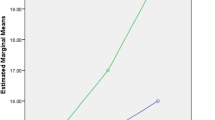Abstract
Purpose
The religious singing is a popular group of professional voice users in Iran which is performed in a sadness form to persuade the audiences to cry and think to holy persons. This style has its own unique vocal demands and abuses. Therefore, the present study, for the first time, aimed to investigate the prevalence of self-reported vocal complaints, vocal discomfort symptoms, and its effects on the vocal-related life of the Iranian religious singers.
Methods
In a cross-sectional study, 62 religious singers (28 women, 34 men) completed Singers Voice Handicap Index (SVHI), Vocal Tract Discomfort (VTD), and also a non-standard self-rated vocal complaint question. Spearman correlation test was applied to analyze correlations. Furthermore, 39 non-singers (18 women, 21 men) as a control group participated in this study.
Results
The religious singer’s mean score of the SVHI test was 34.84 (SD = 24.89). According to the self-rated vocal complaint question, almost 80% of the participants reported mild to the severe vocal complaints that was significantly higher than control group which was about 10%. The self-rated complaints indicated a significant positive correlation with the SVHI and the VTD reported by singers (p ≤ 0.001). The mean scores of the VTD symptoms in singers were significantly greater than control group. There was also a significant positive correlation between the two VTD and SVHI tests (p ≤ 0.001).
Conclusion
Religious singers are at a great risk of developing voice problems. Therefore, their vocal demands and requirements need to be followed precisely. The SVHI and VTD tests should also be considered as two efficient tools for religious singers.
Similar content being viewed by others
Availability of data and material
All authors confirm that all materials as well as software application or custom code support their published claims and comply with field standards. Authors agree to deposit data that support the findings of the research in a public repository and confirm its agreement with the standards.
Code availability
Not applicable.
References
Titze I, Lemke J, Montequin D (1997) Populations in the U.S. Workforce who rely on voice as a primary tool of trade: a preliminary report. J Voice 11:254–259
Vilkman E (2000) Voice problems at work: a challenge for occupationalsafety and health arrangement. Folia Phoniatri Logop 52:20–125
Benninger MS, Jacobsen BH, Johnson AF (1994) Vocal arts medicine: the care and prevention of professional voice disorders. Thieme Inc, New York
Wingate JM, Brown WS, Shrivastav R, Davenport P, Sapienza CM (2007) Treatment outcomes for professional voice users. J Voice 21(4):433–449
Murry T, Zschommler A, Prokop (2009) Handicap in singers. J Voice 23(3):376–379
Seifpanahi S, Izadi F, Jamshidi A, Torabinezhad F, Sarrafzadeh J, Sobhani-Rad D, Ganjuie M (2016) Prevalence of voice disorders and associated risk factors in teachers and nonteachers in Iran. J Voice 30(4):506.e19–23
De Jong FI, Kooijman PG, Thomas G, Huinck WJ, Graamans K, Schutte HK (2006) Epidemiology of voice problems in Dutch teachers. Folia Phoniatr Logop 58:186–198
Emerich KA, Titze IR, Švec JG et al (2005) Vocal range and intensity in actors: a studio versus stage comparison. J Voice 19:78–83
Zeine L, Waltar KL (2002) The voice and its care: survey findings from actors’ perspectives. J Voice 16:229–243
Miller M, Verdolini K (1995) Frequency of voice problemsreported by teachers of singing and control subjects andrisk factors. J Voice 31:68–69
Phyland DJ, Oates J, Greenwood KM (1999) Self-reported voice problems among three groups of professional singers. J Voice 13:602–611
Verdolini K, Ramig LO (2001) Review: occupational risks for voice problems. Logoped Phoniatr Vocol 26:37–46
Pestana PM, Vaz-Freitas S, Manso MC (2017) Prevalence of voice disorders in singers: systematic review and meta-analysis. J Voice 31:722–727
Prebil CN, Hočevar Boltežar I, Šereg Bahar M (2020) Risk factors for voice problems in professional actors and singers. Zdr Varst 59(2):92–98
Akbari E, Seifpanahi S, Ghorbani A, Izadi F, Torabinezhad F (2018) The effects of size and type of vocal fold polyp on some acoustic voice parameters. Iran J Med Sci 43(2):158–163
Seifpanahi S, Izadi F, Jamshidi A, Shirmohammadi N (2017) Effects of transcutaneous electrical stimulation on vocal folds adduction. Eur Arch Otorhinolaryngol 274:3423–3428
Treole K, Trudeau MD (1997) Changes in sustained production tasks among women with bilateral vocal nodules before and after voice therapy. J Voice 11:462–469
Cohen SM, Witsell DL, Scearce L, Vess G, Banka C (2008) Treatment responsiveness of the singing voice handicap index. Laryngoscope 118(9):1705–1708
Seifpanahi S, Jalaie Sh, Nikoo MR, Sobhani-Rad D (2015) Translated Versions of Voice Handicap Index (VHI)-30 across languages: a systematic review. Iran J Public Health 44(4):458–469
Rosen CA, Murry T (2000) Voice Handicap Index in singers. J Voice 1:370–377
Mathieson L, Hirani SP, Epstein R, Baken RJ, Wood G, Rubin JS (2009) Laryngeal manual therapy: a preliminary study to examine its treatment effects in the management of muscle tension dysphonia. J Voice 23:353–366
Pinheiro J, Silverio KCA, Siqueira LTD et al (2017) Correlation between vocal tract symptoms and modern singing handicap index in church gospel singers. CoDAS 29(4):e20160187
Cohen SM, Jacobson BH, Garrett CG et al (2007) Creation and validation of the singing voice handicap index. Ann Otol Rhinol Laryngol 116:402–406
Abou-Elsaad T, Baz H, Omayma A et al (2017) Validation and adaptation of the singing voice handicap index for Egyptian singing voice. J Voice 31:130e1-130e6
Baracca G, Cantarella G, Forti S et al (2014) Validation of the Italian version of the singing voice handicap index. Eur Arch Otorhinolaryngol 271:817–823
Lee AR, Sim HS (2013) The Korean version of the singing voice handicap index. Commun Sci Disord 18:194–202
Ghaemi H, Dehqan A, Mahmoodi-Bakhtiari B, Sobhani-rad D (2020) The Singing Voice Handicap Index (SVHI): validation and adaptation into Persian. J Voice 34(1):158.e17-158.e23
Phyland DJ, Pallant JF, Thibeault SL, Benninger MS, Vallance N, Smith JA (2014) Measuring vocal function in professional music theater singers: construct validation of the Evaluation of the Ability to Sing Easily (EASE). Folia Phoniatr Logop 66(3):100–108
Thalén M, Sundberg J (2001) Describing different styles of singing: a comparison of a female singer’s voice source in “Classical”, “Pop”, “Jazz” and “Blues.” Logoped Phoniatr Vocol 26:82–93
Nooshin L (2003) Improvisation as‘Other’: creativity, knowledge and power—the case of Iranian classical music. J R Musical Assoc 128:242–296
Azadehfar MR (2006) Rhythmic structure in Iranian music. Tehran Art University Press, Tehran
Williams NR (2003) Occupational groups at risk of voice disorders: a review of the literature. Occup Med 53:456–460
Devadas U, Hegde M, Maruthy S (2019) Prevalence and risk factors of self-reported voice problems among Yakshagana Artists. J Voice 33(1):124.e35-124.e47
Devadas U, Kumar PC, Maruthy S (2020) Prevalence of and risk factors for self-reported voice problems among Carnatic singers. J voice 34(2):303.e1-303.e15
Naseri-nezhad A (2016) The principles of religious singing (Maddahi). Kowsar kavir Pub
Hollien H, Moore P, Wendahl RW et al (1996) On the nature of vocal fry. J Speech Lang Hear Res 9:245–247
Plexico LW, Sandage MJ (2017). Influence of glottal fry on acoustic voice assessment: a preliminary study. J Voice 31(3):378.e13–378.e17
Rosa M, Behlau M (2017) Mapping of vocal risk in amateur choir. J Voice 31:118.e1-118.e11
Ravall S, Simberg S (2018) Voice disorders and voice knowledge in Choir Singers. J Voice 34(1):157.e1-157.e8
Torabi H, Khoddami M, Nakhostin-Ansari N, Dabirmoghaddam P (2016) The Vocal Tract Discomfort Scale: validity and reliability of the Persian version in the assessment of patients with muscle tension dysphonia. J Voice 30(6):711–716
Prestes T, Pereira EC, Bail DI, Dassie-Leite AP (2012) Desvantagem vocal em cantores de igreja. Rev CEFAC 14(5):901–909
Barreto TMM, Amorim GO, Trindade EMF, Kanashiro CA (2011) Perfil da saúde vocal de cantores amadores de igreja evangélica. Rev Soc Bras Fonoaudiol 16(2):140–145
Cohen SM, Jacobson BH, Garrett CG, Noordzij JP, Stewart MG, Attia A et al (2007) Creation and validation of the singing voice Handicap Index. Ann Otol Rhinol Laryngol 116(6):402–406
Baracca G, Cantarella G, Forti S, Pignataro L, Fuss F (2014) Validation of the Italian version of the Singing Voice Handicap Index. Eur Arch Otorhinolaryngol 271:817–823
Rodrigues G, Zambon F, Mathieson L, Behlau M (2013) Vocal tract discomfort in teachers: its relationship to self-reported voice disorders. J Voice 27(4):473–480
Cappellaroand J, Beber BC (2018) Vocal tract discomfort and voice-related quality of life in wind instrumentalists. J Voice 32(3):314–318
Acknowledgements
The authors thank religious singer club (Basijmaddahan) personnel for their cooperation in performing this research. In addition, we appreciate to Vice chancellor for research and technology of Hamadan University of Medical Sciences that financially supported this study with approved research number 9704262270.
Funding
This research was financially supported by Vice chancellor for research and technology of Hamadan University of Medical Sciences.
Author information
Authors and Affiliations
Contributions
All authors contributed to the study conception and design. Material preparation, data collection and analysis were performed by M-SS, BB, SGG, and MR. The first draft of the manuscript was written by M-SS, and all authors commented on previous versions of the manuscript. All authors read and approved the final manuscript.
Corresponding author
Ethics declarations
Conflict of interest
The authors declare that they have no conflict of interest.
Ethical approval
All procedures performed in studies involving human participants (including this study) were in accordance with the ethical standards of the institutional (Ethical committee of Hamadan University of Medical Sciences; Number: IR.UMSHA.REC.1397.229) and with the 1964 Declaration of Helsinki and its later amendments or comparable ethical Standards.
Consent to participate
Informed consent was obtained from all individual participants included in the study.
Consent for publication
The authors affirm that human research participants provided informed consent for publication of the all tables included in the manuscript.
Additional information
Publisher's Note
Springer Nature remains neutral with regard to jurisdictional claims in published maps and institutional affiliations.
Rights and permissions
About this article
Cite this article
Seifpanahi, MS., Bayat, B., Ghorbani Gholiabad, S. et al. Self-rated vocal complaints relationship to Vocal Tract Discomfort and Singers Voice Handicap Index in Iranian religious singers. Eur Arch Otorhinolaryngol 278, 2411–2419 (2021). https://doi.org/10.1007/s00405-021-06741-5
Received:
Accepted:
Published:
Issue Date:
DOI: https://doi.org/10.1007/s00405-021-06741-5




